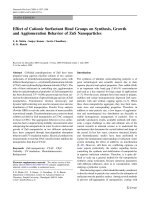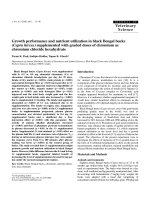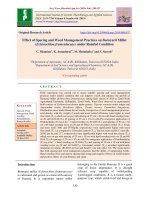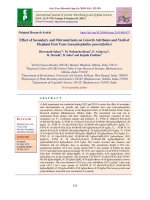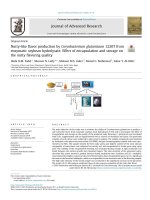Assess the effect of concentrate and mineral mixture on the growth and reproductive performances in black Bengal goats
Bạn đang xem bản rút gọn của tài liệu. Xem và tải ngay bản đầy đủ của tài liệu tại đây (204.06 KB, 7 trang )
Int.J.Curr.Microbiol.App.Sci (2020) 9(7): 2702-2708
International Journal of Current Microbiology and Applied Sciences
ISSN: 2319-7706 Volume 9 Number 7 (2020)
Journal homepage:
Original Research Article
/>
Assess the Effect of Concentrate and Mineral Mixture on the Growth and
Reproductive Performances in Black Bengal Goats
S. Shekhar*
Krishi Vigyan Kendra, (ICAR-NRRI), Jainagar, Koderma- 825324, Jharkhand, India
*Corresponding author
ABSTRACT
Keywords
Castrated male,
Does, Serum
glucose,
Concentrate,
Mineral mixture,
Kid, Mortality
Article Info
Accepted:
22 June 2020
Available Online:
10 July 2020
An on farm trial was conducted to evaluate the effect of concentrate and minerals mixture
on growth and reproductive performances of black Bengal goat. The whole trial was
divided in to two parts; in first part 45 castrated male goats were selected and divided in
three groups. The castrated male goats of group FP were supplemented with gram husk 50
gram/goat/day whereas, group T1 were supplemented with concentrate 100 gram/goat/day
and group T2 were supplemented with concentrate 100 gram/goat/day and mineral mixture
10 gram/goat/day. In second part 45 pregnant does were selected and divided in to three
groups. The pregnant does of group PC were supplemented with gram husk 200
gram/goat/day whereas, group TP1 were supplemented with 300 gram of concentrate and
group TP2 were supplemented with 300 gram concentrate/goat/day and mineral mixture
10 gram /does /day. The body weight gain in castrated male goat and pregnant does were
significantly (P<0.05) higher in both the supplemented groups as compared to farmers
practice group. The biochemical study revealed that non-significant (P<0.05) variation in
Hb, total protein, albumin, globulin, A: G ratio and BUN level and significant (P<0.05)
increase in blood glucose, Ca, P, Cu and Zn level were recorded in both the treatment
groups. The significantly (P<0.05) higher peri-parturient body weight, placenta weight,
birth weight of kids and significantly (P<0.05) lower kid mortality were recorded in
concentrate and mineral mixture supplemented groups than farmers practice group.
Introduction
Goats scattered all over the world because
their immense adaptability to varying
environmental conditions. India holds the
second largest population of goat in the world
as 125.7 million which is 14.6% of world’s
goat population and 24.4% of Asia’s goat
population and number of goats in the world
has been increasing since 1990 by about 1%
to 4 % each year (FAOSTAT, 2012). They
proved very useful to man throughout the
ages due to their productivity, small size, and
non-competitiveness for food. In the
developing countries, goats make a very
valuable contribution in improve economic
status especially land less and poor farmers
so, goats termed as “Poor man’s cow”. But
the importance of this valuable livestock is
under estimated and its contribution to the
uplifment the economic status of the poor
goat keepers is inadequately understood.
2702
Int.J.Curr.Microbiol.App.Sci (2020) 9(7): 2702-2708
Goats are often neglected in comparison with
cattle and sheep. Now, it is the time to
consider and pay attention to the value and
capacity of goats for producing food. In
Jharkhand, Black Bengal breed of goat is
mainly reared by poor and landless farmers.
The breed is famous for its high prolificacy,
tasty meat (chevon) and leather quality
(Husain et al., 1998). The breed attains early
sexual maturing and first kidding takes place
at the age of about 12 months. They give kid
twice in a year or more commonly thrice in
two years (Zeshmarani et al., 2007) and the
number of kid varies from one kid to four
kids. Two kids are very common (56.32%)
and four kids are least common (2.11%)
Hassan et al., 2007. However, the growth and
productivity of the breed was very low under
the prevailing extensive system of rearing. In
this system, goats are maintained under
natural vegetation on degraded community
grazing lands and tree lopping, kitchen waste
etc., but these feed ingredients are lower in
energy, protein content and also deficient of
trace minerals and vitamins. These feed
ingredients are not sufficient for achieving
optimum weight gain and reproductive
performance of goats (Kochapakdee et al.,
1994). The higher body weight gain and
optimum reproductive performance can be
achieved through supplement of concentrate
and mineral mixture (Madibela and
Segwagwe, 2008).
Materials and Methods
An on-farm trial was conducted in year 201718 on male and female Black Bengal goat
(Capra
hircus)
of
Chopnadih
and
Banderchokwa villages of Markachho block
of Koderma, Jharkhand, India to assess the
effect of concentrate and mineral mixture on
the growth and reproductive performance of
black Bengal goat. The trial was divided in to
two parts; in first part 45 castrated male kids
of 4.0 to 4.5 months of age and average live
body weight 5 to 6 kg were selected and
divided in three group viz. FP, T1 and T2.
The details of experimental design were
depicted in Table1.
Feeding trial was continued for 90 days and
the body weights of kids were recorded on 0,
15, 30, 45, 60 and 90 days of feeding trial.
Blood samples were collected at 0 day and 90
days of trial. The haemato- biochemical
parameters viz. Hb, total protein, albumin,
globulin, A: G ratio and glucose, BUN were
estimated by commercial kit (Span
Diagnostics Ltd., India). The minerals viz. Ca,
Cu and Zn were estimated through Atomic
Absorption spectrophotometer, Attri (2003)
and
serum
Pi
estimated
in
UV
spectrophotometer by UV molybadate method
described by Tietz (1998).
In second part 45 pregnant does of
approximately 2.0 to 2.5 month pregnant,
average body weight 12 to 13 kg body weight
and 10 to 12 months of age were randomly
divided in to three groups’ viz. PC, TP1 and
TP2. The details of experimental design were
depicted in Table 2. The pre trial body weight
of does, body weight at the time of
parturition, post kidding body weight of does,
litter size, placenta weight, birth weight of kid
and mortality (%) of kids up to 4 weeks were
recorded.
Goats of each group were kept in separate
shed and provide ad libitum water. This
schedule was followed till the end of
experiment. All the goats were send for
grazing 4 to 5 hrs in a day. The male goats
and female goats were dewormed 15 days
prior to the trial with Albendazole and
Fenbendazole respectively @ 7.5 mg/kgb.wt.
The vaccination schedules were followed as
per standard protocol. The proximate analysis
of the concentrate mixture was estimated as
per AOAC (2000) (Table-3).
2703
Int.J.Curr.Microbiol.App.Sci (2020) 9(7): 2702-2708
Data analysis was done using software SPSS
16.0. Data pertaining to body weight were
analyzed by ANOVA technique to assess the
significance of means as per the method
described by Snedecor and Cochran (1994).
Results and Discussion
The mean body weight on 0, 15, 30, 45, 60,
75 and 90 days of trial in different groups of
castrated male black Bengal goats were
depicted in Table 5. The mean body weight of
castrated male goats at 90 days of trial in
group FP, T1 and T2 were recorded 8.57 ±
0.32, 9.61 ± 0.29 and 10.17 ± 0.29 Kg
respectively. The mean body weight at the
time of parturition in does were recorded
16.33 ± 2.18, 18.13 ± 2.12 and 18.83 ± 2.42
Kg respectively in control group, concentrate
group and concentrate and mineral mixture
supplemented group were Table 7. The body
weight gain in castrated male goat and
pregnant does were significantly (P<0.05)
higher in supplemented groups than farmers
practice (control) group. Between the
supplemented groups significantly (P<0.05)
higher mean body weight was recorded in
concentrate
with
mineral
mixture
supplemented group (T2). The higher body
weight of goats in concentrate with minerals
mixture supplemented group might be due to
addition of extra energy, protein, minerals and
vitamins in diet and better utilization of
nutrients. The present findings are in
accordance with findings of Niaz, (2017),
Tiwari et al (2014), Kabirul and Jannatara,
(2013), Sultana et al., (2012) and Yadav et al
(2010). The non significant (P<0.05) variation
in Hb, total protein, albumin, globulin, A:G
ratio and BUN level were recorded among the
groups. Similar findings obtained by earlier
works Niaz, (2017), Porwal et al., (2005. In
contrast to the present findings Sahlu et al.,
(1995)
recorded
significant
(P<0.05)
increased in serum total serum protein
concentration after addition of energy in diet
of pregnant goats. Significant (P<0.05)
increased in glucose level were recorded in
the goats of T1 and T2 groups as compared to
the goats of control group. Increased serum
glucose level was also recorded by earlier
workers More et al., (2008), Singh and
Shinde (1997). The high serum glucose level
in concentrate feeding group and concentrate
with mineral mixture feeding group might be
due increase levels of volatile fatty acids
(acetic, propionic and butyric) provide more
gluconeogenic precursors in the body resulted
in to increased plasma glucose level. The
average serum Ca, P, Cu and Zn in goats of
different control group and treatment groups
were depicted in Table-6. The significant
(P<0.05) increased in Ca, P, Cu and Zn
concentration on 90 days of trial in both
treatment groups as compared to control
group might be due to incorporation of
concentrate and mineral mixture provide extra
minerals in the body. Similar findings were
also reported by Agrawalla et al., 2017; Niaz
et al, 2017.
Table.1 Experimental design for effect of concentrate and mineral mixture in male goat
Group
No. of male Technology option
Goat/group
Farmers practice
(FP)
T1
15
T2
15
15
Grazing 4 to 5 hrs in a day and supplemented with gram husk @
50 gram/goat/day for 90 days.
Grazing 4 to 5 hrs in a day and supplemented with concentrate
mixture e@ 100 gram/goat/day for 90 days.
Grazing 4 to 5 hrs in a day and concentrate @ 100 gram/goat/day
and mineral mixture 10 gram/goat/day for 90 days.
2704
Int.J.Curr.Microbiol.App.Sci (2020) 9(7): 2702-2708
Table.2 Experimental designs for effect of concentrate and mineral mixture in pregnant female
goat (does)
Group
No. of female goat
/group
Technology option
Farmers
practice (PC)
TP1
15
TP2
15
Grazing 4 to 5 hrs in a day and supplemented with gram husk @
200 gram/goat/day for 90 days or till parturition.
Grazing 4 to 5 hrs in a day and supplemented with concentrate
mixture @ 300 gram/goat/day for 90 days or till parturition.
Grazing 4 to 5 hrs in a day and concentrate @ 300 gram/goat/day
and mineral mixture 30 gram/goat/day for 90 days or till
parturition.
15
Table.3 Chemical composition of concentrate mixture fed to black Bengal goat (on % DM basis)
S. No.
1.
2.
3.
4.
5.
6.
7.
8.
9.
Chemical composition
Dry matter
Organic matter
Crude protein
Ether extract
Crude fibre
Nitrogen free extractives
Total ash
Neutral detergent fibre*
Acid detergent fiber*
Concentrate Mixture
90.60
92.70
20.70
4.41
9.52
52.46
7.30
26.15
16.13
*Determined on ash-free basis
Table.4 Composition of mineral mixture fed to the black Bengal goat
S. No.
1.
2.
3.
4.
5.
6.
7.
8.
9.
10.
11.
12
13.
14.
15.
16.
17.
18.
Ingredient
Calcium
Phosphorus
Magnesium
Manganese
Iron
Iodine
Copper
Zinc
Cobalt
Sulphur
Potassium
Sodium
Selenium
Vitamin A
Vitamin D3
Vitamin E
Nicotinamide
Chromium
Nutritional value in1.2 kg
255 gm
127.5 gm
6.0 gm
1.5 gm
1.5 gm
325 mg
4.2 g
9.6 g
150 mg
7.2 g
100 mg
6 mg
10 mg
700000IU
70000IU
250 mg
1000mg
78 mg
2705
Int.J.Curr.Microbiol.App.Sci (2020) 9(7): 2702-2708
Table.5 Effect of concentrate and mineral mixture supplementation on mean body weight (Mean
± SE) of castrated male black Bengal goat
Group
FP
T1
T2
0 day
5.73 ± 1.26a
5.45 ± 0.86 a
5.62 ± 1.16 a
15 day
5.80 ± 1.26 a
6.11 ±1.31 a
6.27 ±1.22 a
30 day
6.39± 1.22 a
6.75 ± 1.22 a
6.88 ± 1.22 a
45 day
7.15± 0.52 a
7.54± 0.74 a
7.94± 0.82 a
60 day
7.75 ± 0.48 a
8.56 ± 0.47 ab
9.12 ± 0.34 b
75 day
8.31± 0.32 a
9.17± 0.29 b
9.64± 0.37 c
90 day
8.57± 0.32 a
9.61± 0.29 c
10.17± 0.29 d
Means bearing different superscripts in column differed significantly (P < 0.05)
Table.6 Effect of concentrate and mineral mixture supplementation on haematological, bio
chemicals and minerals status in black Bengal goat
Parameters
Hb (g/dl)
Total Protein (g/dl)
Albumin (g/dl)
Globulin (g/dl)
A/G ratio
Glucose (mg/dl)
BUN (mg/dl)
Ca (mg/dl)
P (mg/dl)
Cu (ppm)
Zn (ppm)
FP
0 day
90 day
10.15 ±0.16
10.45 ±0.16
6.57 ±0.15
6.61 ±0.17
3.51 ±0.24
3.65 ±0.19
3.06 ±0.27
2.96 ±0.22
1.14 ± 0.25
1.23 ± 0.21
43.70 ±3.11 a 44.15 ±3.11a
41.75 ±1.12
40.15 ±0.52
a
8.13 ±0.19
8.28±0.21 a
4.18 ±0.19 a
4.20 ±0.19 a
0.54±0.075 a
0.49 ±0.045a
0.66 ±0.09 a
0.71±0.12 a
T1
0 day
10.44 ±0.32
6.49 ±0.23
3.57 ±0.27
2.92 ±0.21
1.22 ± 0.23
44.10 ±3.11 a
40.27 ±1.45
8.21 ±0.16 a
4.22 ±0.19 a
0.57±0.052 a
0.67±0.17 a
90day
10.37 ±0.16
6.65 ±0.21
3.84 ±0.17
2.42 ±0.19
1.54 ± 0.21
54.64 ±1.48b
41.25 ±0.45
8.37±0.21 ab
4.78 ±0.11 b
0.72±0.042 b
0.79 ±0.19 b
T2
0 day
90day
10.28 ±0.16 10.28 ±0.27
6.54 ±0.25
6.69 ±0.18
3.64 ±0.21
3.85 ±0.19
2.91 ±0.17
2.84 ±0.22
1.25 ± 0.13
1.35 ± 0.18
43.60 ±3.71a 55.64 ±1.38b
42.14 ±0.16 40.24 ±0.44
8.12 ±0.24 a
8.77±0.23 b
4.17±0.19 a
5.22 ±0.21 b
0.51 ±0.081 a 0.78±0.042 b
0.65±0.14 a
0.84 ±0.11 b
Means bearing different superscripts in column differed significantly (P< 0.05)
Table.7 Effect of concentrate and mineral mixture supplementation on body weight and
reproductive performance of does
Parameters
Pre trial body wt. of does (Kg)
B. wt. of does at the time of
parturition(Kg)
B. wt. of does after kidding (Kg)
Placenta weight(g)
Litter size (no.)
Birth weight of kids (kg)
Mortality of kids 0 to 4 wks (%)
PC
12.43±1.78 a
16.33±2.18 a
TP1
13.12 ± 1.89 a
18.13±2.12 b
TP2
12. 65 ± 1.37 a
18.83± 2.42 c
13.63±1.18 a
195.5±12.1 a
1.5±0.15
1.01 ±0.4 a
15.25 ±1.85 a
14.43±2.12 b
240.12 ±10.4 b
1.5 ±0.17
1.25 ±0.4 b
10.78 ±1.75 b
14.87 ±1.92 b
270.57±11.7 c
1.5±0.12
1.45 ±0.4 c
7.35 ±1.35 c
Means bearing different superscripts in column differed significantly (P < 0.05)
The placental weight were varies significantly
(P<0.05) in both treatment groups with
comparison to control group. The birth weight
of kids in concentrate and concentrate and
mineral mixture supplemented groups were
significantly higher as compared to control
groups. The litter size (no.) of black Bengal
goats were varies non significant (P<0.05) in
2706
Int.J.Curr.Microbiol.App.Sci (2020) 9(7): 2702-2708
treated groups and control group. The litter
size varies with 1 to 3 kids and occasionally 4
kids depend on plain of nutrition and parity of
the does (Hassan et al., 2007; Kabirul and
Jannatara, 2013). The birth weight of kids
were 1.01 ± 0.4, 1.25 ± 0.4 and 1.45 ± 0.4 kg
in control group, concentrate supplement
group and concentrate with mineral mixture
supplemented group respectively. The present
finding is in accordance with findings of
earlier workers Ferdous et al., (2011); Salim
et al., (2002) and Singla et al., (2014). Kids
mortality up to 1 months of age in control
group, concentrate supplement group and
concentrate
and
mineral
mixture
supplemented were recorded 15.25 ± 1.85,
10.78 ± 1.75 and 7.35 ± 1.35 percentage
respectively. The lowest kid mortality in
mineral supplemented group might be due to
better plain of nutrition in gestation period
increase birth weight of kid and result into
decrease in kid mortality. The findings are in
agreement the findings of Mude et al, (2010).
It may conclude from the study that
supplementation of concentrate @ 100
gram/goat/day and mineral mixture 10
gram/goat/day for 90 days increase body
weight and mineral status in castrated male
goat and supplementation of concentrate @
300 gram/does/day and mineral mixture 30
gram/does/day for 90 days or till parturition,
increase body weight of pregnant does,
placenta weight, kids birth weight and
decrease kid mortality in black Bengal goats.
References
Agrawalla, J., Sethy, K., Behera, K., Swain,
R.K., Mishra, S.K. and Sahoo, N. (2017).
Improved reproductive performance of
crossbred cattle in Puri district of Odisha
following supplementation of area
Specific mineral mixture. Indian Journal
of Animal Reproduction. 2017; 38(2):4345.
AOAC. (2000). Officials Methods of Analysis,
17th edn. Association of Official
Analytical Chemists, Washington, DC.
Attri, A. (2003). Studies on clinico-therapeutic
efficacy of tropical formulations of
dermatoses
and
gastro
intestinal
helminthoses of dogs. Thesis, M.V.Sc.
G.B.P.U.A.T., Pantnagar. 26 P.
F A.O.S.T.A.T. (2012). Web: www.faostat.org.
Ferdous, M.R., Khan, M.J., Rashid, M.A. and
Kamruzzaman, M. (2011). Effect of
different
levels
of
concentrate
supplementation on the performance of
Black Bengal goat. Bang. J. Anim. Sci.
40: 40-45.
Hassan, M. M., NiazMahmud, S.M., Azizul
Islam, S.K.M., Faruk Miazi, O. (2007). A
comparative study on reproductive
performance and productivity of the
Black Bengal and Crossbred goat at Atrai,
Bangladesh. Univ. J. Zool. Rajshahi
Univ., 26: 55–57
Husain, S.S., Amin, M.R., Islam, A.B.M.M.
(1998): Goat production and its Breeding
Strategy in Bangladesh. Proceeding of
first national workshop on Animal
Breeding,
Bangladesh
Agricultural
University, Mymensingh, Bangladesh.
Kabirul, I. K. and Jannatara, K. (2013).
Different traits of black bengal goats
under two feeding Regime and fitting the
gompertz curve for prediction of Weaning
weight in the semi-scavenging system.
Indian J. Anim. Res. 47 (6): 498-503.
Kochapakdee, S., Pralomkam, S., Saitanoo, A.
and Norton, B.W. (1994). Productivity of
female goat grazing newly established
pasture
with
varying
levels
of
supplementary feeding. Asian-Aust. J.
Anim. Sci. 7: 289-293.
Madibela, O.R., Segwagwe, B.V.E. (2008)
Nutritional effects of supplementary
feeding on maternal blood metabolites,
cortisol, thyroid hormones levels and on
outcome of pregnancy of dry season
kidding
Tswana
goats.
Livestock
Research and Rural Development, 20, 4.
More, A.D., Deshpande, S.D. and Jinke, M.R.
(2008). Serum glucose, total lipid and
total cholesterol levels in yearling
2707
Int.J.Curr.Microbiol.App.Sci (2020) 9(7): 2702-2708
Osmanabadi goats. Indian Journal of
Small Ruminants. 14:971-987.
Mude, S.W., Waghmare, S.P., Mode S.G.,
Sukare P.G.and Adlak, S.A. (2010).
Effect of mineral supplementation on
post-parturient diseases in pregnant goat.
Veterinary World, 3 (3): 109-110.
Niaz, F., Sethy, K., Swain, R.K., Behera, K.,
Mishra, S.K. Karna, D.K. and Mishra, C.
(2017). Combined effect of concentrate
and area specific mineral mixture
supplementation on the performance of
Ganjam goat in its native tract. The
Pharma Innovation Journal, 6(10): 320323.
Porwal, P., Karim, S.A., Agrawal, A. and
Singh, V.K. (2005). Blood biochemical
profile of lamb maintained under different
system of feeding management. Indian
Journal of Small Ruminants. 11:166-171.
Sahlu, T., Hart, S.P., Letrong, T., Jia, Z.,
Dawson, L. and Gipson, T. (1995).
Influence of prepartum protein and energy
concentrations for dairy goats during
pregnancy and early lactation. Journal of
Dairy Science. 78:378-387.
Salim, H.M., Shahjalal, M., Tareqe, A.A.M. and
Kabir, F. (2002). Effect of concentrate
supplementation
on
growth
and
reproductive performance in female sheep
and goats under grazing condition.
Pakistan J. of Nutrition. 1(4): 191-193.
Singh, N.P. and Shinde, A.K. (1997). Blood
metabolite and mineral profile of lactating
goats on rangelands with or without
concentrate supplementation. Indian
Journal of Small Ruminants. 3(1):98579871.
Singla, M., Sirohi, A.S., Lamba, J.S. and Ahuja,
C.S. (2014). Effect of soaked and boiled
concentrate feeding on growth, VFA’s
production and blood biochemistry of
stall-fed beetal kids. Indian J. Anim. Res.
48 (5): 448-451.
Snedecor, G.W. and Cochran, W.G. (1994).
Statistical Methods. 8th Edn., East West
Press Pvt. Ltd., New Delhi.
Sultana, S., Khan, M.J., Hassan, M.R. and
Khondoker, M.A.M.Y. (2012). Effects of
concentrate supplementation on growth,
reproduction and milk yield of Black
Bengal
goats
(Caprahircus).
The
Bangladesh Veterinarian. 29(1): 7 – 16.
Tietz, N. W. (1998). Fundamentals of Clinical
Biochemistry. 3rdedn. W. B. Saunders
Company, U.S.A.
Tiwari, R. K., Sachan, V. K., Singh, N. K.
Nautiyal P., Papnai, G. and Gupta, J. P.
(2014) Effect of supplementing mineral
Mixture daily on body weight gain in
male goats. J Krishi Vigyan, 3(1): 24-26.
Yadav, C.M., Khan, P., Panwar, P., Jeenagar,
K. L., Lakhawat, S. S. and Nagar, K. C.
(2010). Effect of concentrate and mineral
mixture supplementation on growth
performance of growing goats. The Indian
Journal of Small Ruminants, 16 (1):10910.
Zeshmarani,S., Dhara, K.C., Samanta, A.K.,
Samanta, R., Majumder, S.C. (2007).
Reproductive performance of goats in
Eastern and Northeastern India. Livestock
Res. Rural Dev., 19: 8.
How to cite this article:
Shekhar, S. 2020. Assess the Effect of Concentrate and Mineral Mixture on the Growth and
Reproductive Performances in Black Bengal Goats. Int.J.Curr.Microbiol.App.Sci. 9(07): 27022708. doi: />
2708

